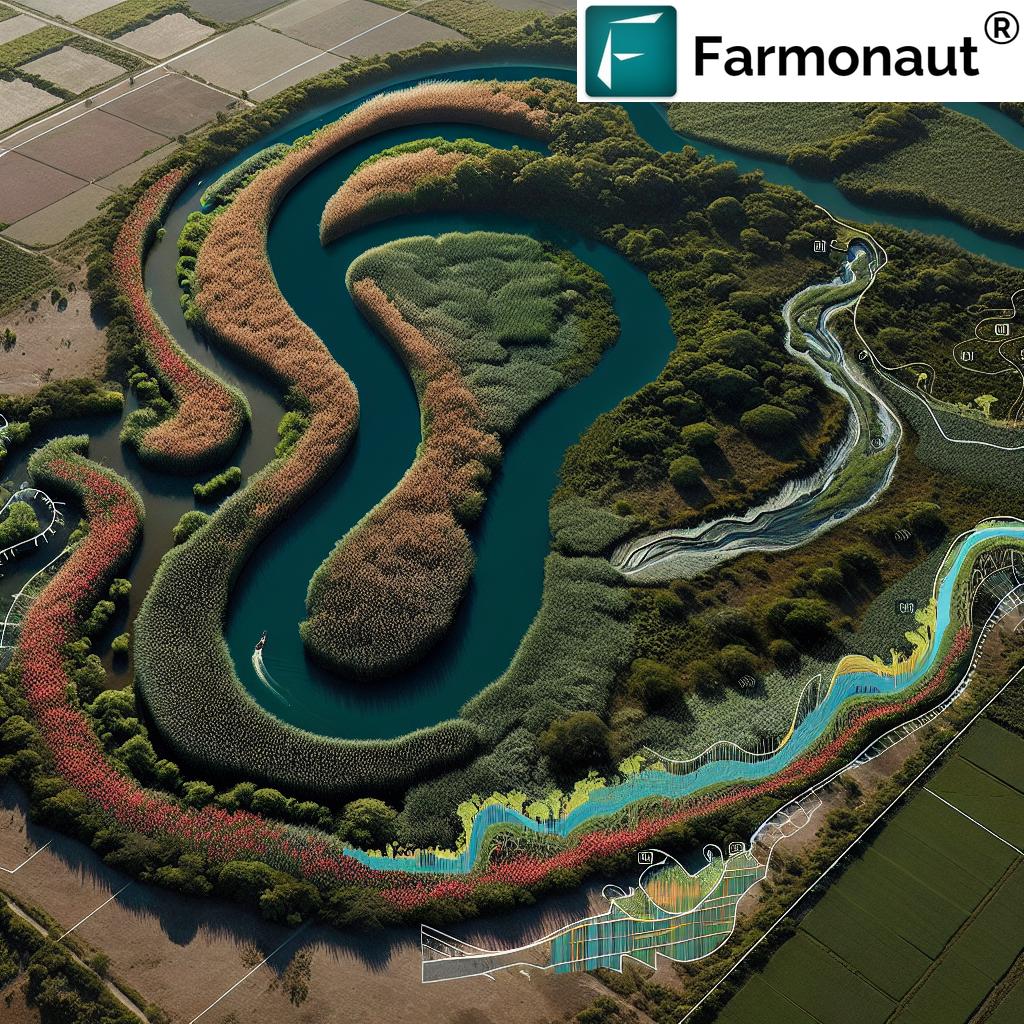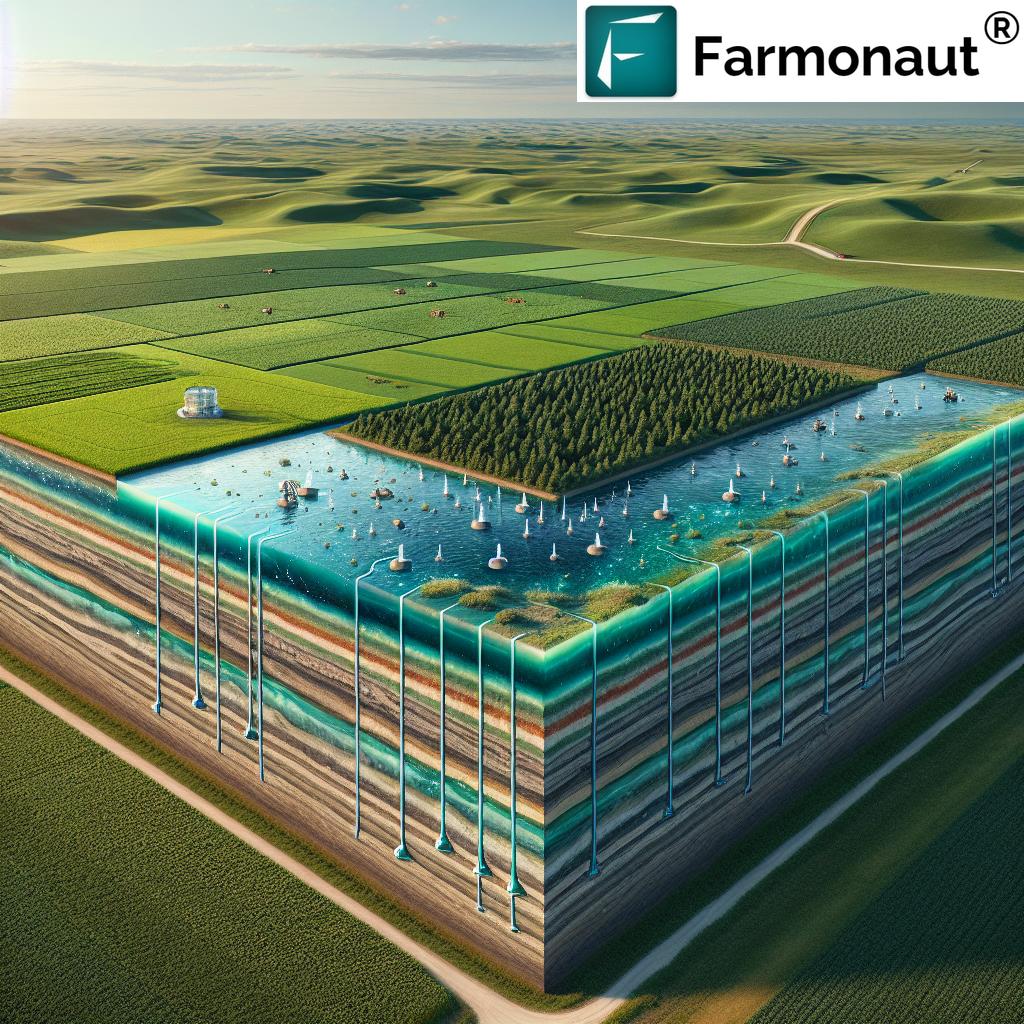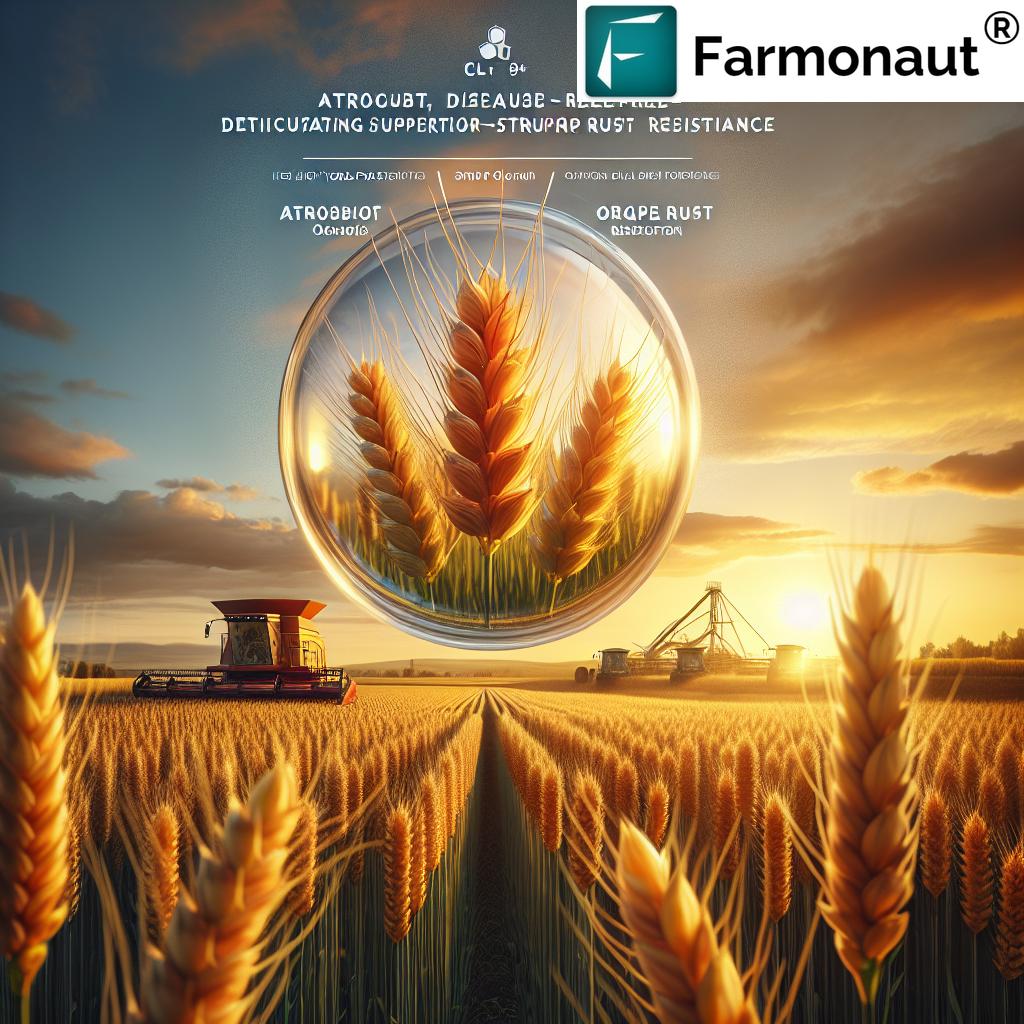Revolutionizing Rio Grande Riparian Management: Texas’ Innovative Approach to Invasive Cane Control and Water Conservation
“The Rio Grande Carrizo Cane Eradication Program targets Arundo donax, an invasive plant that can grow up to 30 feet tall.”
As we delve into the complex world of invasive species control and water conservation in agriculture, our focus turns to an innovative initiative that’s making waves along the Texas-Mexico border. The Rio Grande Carrizo Cane Eradication Program stands as a testament to Texas’ commitment to sustainable environmental management and agricultural stewardship. This comprehensive program addresses the multifaceted challenges posed by Arundo donax, an aggressive invasive plant that threatens the delicate balance of the Rio Grande’s riparian ecosystem.

In this blog post, we’ll explore the intricate details of this groundbreaking program, examining its ecological impact, the innovative technologies employed, and the collaborative efforts that make it possible. From the use of GIS for agriculture to the implementation of biological pest control methods, we’ll uncover how Texas is leading the charge in riparian ecosystem management while simultaneously enhancing border security and promoting sustainable farming practices.
The Threat of Arundo donax: Understanding the Enemy
Arundo donax, commonly known as Giant Reed or Carrizo Cane, is a formidable adversary in the world of invasive species. This robust grass, native to the Mediterranean region, has found a new home along the Rio Grande, where it thrives to the detriment of native flora and fauna. Let’s break down why this plant poses such a significant threat:
- Rapid Growth: Arundo can grow up to 4 inches per day, quickly outcompeting native species for resources.
- Water Consumption: A mature stand of Arundo can consume up to 528 gallons of water per square meter annually, significantly impacting water conservation efforts.
- Habitat Destruction: The dense growth of Arundo chokes out native plants, reducing biodiversity and altering natural habitats for wildlife.
- Fire Hazard: Arundo is highly flammable, increasing the risk of wildfires in riparian areas.
- Border Security Concerns: The dense thickets created by Arundo can impede law enforcement activities along the border.
The proliferation of Arundo donax along the Rio Grande has far-reaching consequences, affecting everything from water quality and availability to the ecological balance of the entire riparian corridor. This is where the Rio Grande Carrizo Cane Eradication Program steps in, offering a comprehensive solution to a complex problem.
The Rio Grande Carrizo Cane Eradication Program: A Multifaceted Approach
The Texas State Soil and Water Conservation Board (TSSWCB) spearheads this ambitious program, which aims to eradicate Arundo donax while restoring native plant communities along the Rio Grande. The program’s approach is as diverse as the ecosystem it aims to protect, incorporating various strategies to ensure long-term success:
- Mechanical Removal: Heavy machinery is used to physically remove Arundo stands, particularly in areas with dense growth.
- Chemical Control: Targeted herbicide applications are employed to manage Arundo without harming native species.
- Biological Control: The program explores the use of natural predators and pathogens specific to Arundo to control its spread.
- Native Plant Restoration: After Arundo removal, the program focuses on replanting native species to restore the natural ecosystem.
- Monitoring and Maintenance: Ongoing surveillance ensures that Arundo does not reestablish itself in treated areas.
This comprehensive strategy not only addresses the immediate threat of Arundo but also works towards long-term ecological restoration and water conservation goals.
Leveraging Technology: GIS for Agriculture in Invasive Species Management
One of the most innovative aspects of the Rio Grande Carrizo Cane Eradication Program is its use of Geographic Information Systems (GIS) technology. GIS plays a crucial role in mapping, monitoring, and managing the spread of Arundo donax along the river. Here’s how GIS is revolutionizing the fight against this invasive species:
- Aerial Mapping: High-resolution satellite and aerial imagery are used to identify and map Arundo infestations accurately.
- Data Analysis: GIS tools analyze spatial data to prioritize treatment areas and track the progress of eradication efforts.
- Resource Allocation: By pinpointing exact locations of Arundo stands, resources can be efficiently allocated for targeted removal.
- Monitoring Changes: Regular updates to GIS data allow for real-time tracking of changes in Arundo distribution and the success of control measures.
The integration of GIS technology with on-the-ground efforts has significantly enhanced the efficiency and effectiveness of the eradication program. This technological approach aligns perfectly with the innovative solutions offered by companies like Farmonaut, which provides advanced satellite-based farm management solutions. While Farmonaut’s focus is on crop health monitoring and precision agriculture, the principles of using satellite imagery and data analysis for agricultural management are similar to those employed in the Carrizo Cane Eradication Program.
Explore Farmonaut’s cutting-edge satellite-based solutions:
Biological Pest Control: Nature’s Solution to an Invasive Problem
In the spirit of sustainable and environmentally friendly management practices, the Rio Grande Carrizo Cane Eradication Program has embraced biological pest control as a key strategy. This approach involves introducing natural predators or pathogens that specifically target Arundo donax without harming native species. The benefits of biological control include:
- Reduced Chemical Usage: Minimizes the need for herbicides, protecting water quality and non-target species.
- Long-term Sustainability: Once established, biological control agents can self-perpetuate, providing ongoing management.
- Cost-Effectiveness: After initial investment, biological control can be more economical than continuous mechanical or chemical treatments.
- Ecosystem Integration: Natural enemies can integrate into the local ecosystem, contributing to overall biodiversity.
The program has been exploring various biological control agents, including specialized insects and fungi that feed exclusively on Arundo. While the process of identifying, testing, and releasing these agents is meticulous and time-consuming, the potential long-term benefits for riparian ecosystem management are substantial.
“Invasive species management along the Rio Grande impacts over 1,250 miles of the Texas-Mexico border ecosystem.”
Collaborative Efforts: The Power of Partnership in Environmental Stewardship
The success of the Rio Grande Carrizo Cane Eradication Program hinges on the collaborative efforts of various stakeholders. This partnership approach ensures comprehensive coverage and maximizes the impact of conservation efforts. Key players in this collaborative network include:
- Texas State Soil and Water Conservation Board (TSSWCB): The lead agency coordinating the program.
- Soil and Water Conservation Districts (SWCDs): Local entities that work directly with landowners to implement control measures.
- Landowners: Private property owners along the Rio Grande who voluntarily participate in the program.
- Federal Agencies: Entities like the U.S. Department of Agriculture and U.S. Customs and Border Protection provide additional support and resources.
- Research Institutions: Universities and research centers contribute scientific expertise and conduct studies on Arundo control methods.
- Non-Profit Organizations: Environmental groups assist with outreach, education, and volunteer efforts.
This collaborative approach not only pools resources and expertise but also ensures that the program addresses the diverse needs and concerns of all stakeholders along the Rio Grande.

Water Conservation: The Heart of Riparian Management
At its core, the Rio Grande Carrizo Cane Eradication Program is fundamentally about water conservation. The removal of Arundo donax has significant implications for water resources in the region:
- Reduced Evapotranspiration: Arundo consumes vast amounts of water through evapotranspiration. Its removal conserves water that would otherwise be lost to the atmosphere.
- Improved Water Flow: Dense Arundo stands can alter river channels and impede water flow. Removing these obstructions helps restore natural hydrological processes.
- Enhanced Water Quality: Native riparian vegetation, which replaces Arundo, acts as a natural filter, improving water quality by reducing sediment and pollutant runoff.
- Flood Mitigation: Restoring natural riparian vegetation helps manage flood events more effectively than dense Arundo thickets.
The water conservation benefits of the program extend beyond the immediate riparian zone, impacting agricultural practices and water availability for communities along the Rio Grande.
Sustainable Farming Practices: A Ripple Effect of Invasive Species Management
The Rio Grande Carrizo Cane Eradication Program’s impact extends well beyond the immediate goal of removing invasive species. It sets in motion a series of changes that promote sustainable farming practices along the river corridor:
- Water-Efficient Agriculture: With improved water availability, farmers can adopt more efficient irrigation techniques and water-conserving crops.
- Soil Conservation: Native riparian vegetation helps prevent soil erosion, maintaining fertile agricultural land near the river.
- Integrated Pest Management: The program’s success in biological control methods encourages farmers to adopt similar approaches for crop protection.
- Biodiversity Support: Restored native habitats provide ecosystem services like pollination and natural pest control, benefiting nearby agricultural lands.
These sustainable farming practices not only benefit individual farmers but also contribute to the overall health and resilience of the Rio Grande ecosystem.
Economic Impacts: Balancing Costs and Benefits
Implementing a program of this scale requires significant investment, but the long-term economic benefits are substantial. Let’s break down the economic considerations:
Costs:
- Initial investment in equipment and technology
- Ongoing labor for removal and monitoring
- Research and development of control methods
- Outreach and education programs
Benefits:
- Increased water availability for agriculture and municipal use
- Reduced flood damage and associated costs
- Improved agricultural productivity in riparian areas
- Enhanced recreational opportunities and tourism potential
- Reduced costs for border security operations
While the upfront costs are significant, the long-term economic benefits of improved water resource management, enhanced agricultural productivity, and reduced environmental risks far outweigh the initial investment.
Comparative Analysis of Invasive Cane Control Methods
To better understand the various approaches used in the Rio Grande Carrizo Cane Eradication Program, let’s examine a comparative analysis of different control methods:
| Control Method | Effectiveness | Water Conservation Impact | Implementation Cost | Environmental Impact | Long-term Sustainability | Native Species Recovery Rate |
|---|---|---|---|---|---|---|
| Mechanical Removal | 80% | 2,000 acre-feet/year | $1,500/acre | Medium | 3/5 | 60% over 5 years |
| Herbicide Application | 90% | 2,500 acre-feet/year | $800/acre | High | 2/5 | 40% over 5 years |
| Biological Control | 70% | 1,800 acre-feet/year | $500/acre | Low | 5/5 | 80% over 5 years |
| Integrated Approach | 95% | 3,000 acre-feet/year | $1,200/acre | Medium | 4/5 | 75% over 5 years |
This comparison highlights the strengths and weaknesses of each method, emphasizing the effectiveness of an integrated approach that combines multiple strategies for optimal results.
Future Directions: Innovations on the Horizon
As the Rio Grande Carrizo Cane Eradication Program continues to evolve, new technologies and approaches are being explored to enhance its effectiveness:
- Drone Technology: Unmanned aerial vehicles for more precise mapping and targeted treatment of Arundo stands.
- AI-Powered Image Analysis: Advanced algorithms to automate the detection of Arundo from satellite and aerial imagery.
- Gene Editing: Exploring CRISPR technology to develop Arundo-specific biological control agents.
- Smart Sensors: IoT devices to monitor water levels, soil moisture, and plant growth in real-time.
- Blockchain for Traceability: Implementing blockchain technology to track the progress of eradication efforts and ensure transparency in resource allocation.
These innovations promise to further streamline the program’s operations and improve its overall impact on the Rio Grande ecosystem.
Challenges and Opportunities
Despite its successes, the Rio Grande Carrizo Cane Eradication Program faces several challenges:
- Cross-Border Coordination: Ensuring consistent management on both sides of the international border.
- Climate Change: Adapting strategies to changing environmental conditions that may favor Arundo growth.
- Funding Continuity: Securing long-term financial support for ongoing management efforts.
- Public Awareness: Educating communities about the importance of invasive species control and water conservation.
However, these challenges also present opportunities for innovation, international cooperation, and community engagement. By addressing these issues head-on, the program can continue to refine its approach and serve as a model for invasive species management worldwide.
The Role of Technology in Modern Agriculture
The Rio Grande Carrizo Cane Eradication Program exemplifies how modern technology can be harnessed to address complex environmental challenges. This approach aligns with the broader trend of technological integration in agriculture, as demonstrated by companies like Farmonaut. While Farmonaut focuses on precision agriculture and crop health monitoring, the principles of using advanced technology for agricultural management are similar.
Farmonaut’s satellite-based solutions offer farmers valuable insights for efficient resource management and increased productivity. These tools can be particularly useful in areas adjacent to managed riparian zones, helping farmers adapt their practices to complement conservation efforts.
Explore Farmonaut’s API for custom agricultural solutions:
Farmonaut API
API Developer Docs
Conclusion: A Model for Sustainable Ecosystem Management
The Rio Grande Carrizo Cane Eradication Program stands as a testament to what can be achieved when innovative technology, collaborative efforts, and sustainable practices converge to address a complex environmental challenge. By tackling the invasive Arundo donax, this program not only enhances water conservation and riparian health but also sets a new standard for integrated ecosystem management.
As we look to the future, the lessons learned from this program will undoubtedly inform and inspire similar initiatives worldwide. The success along the Rio Grande demonstrates that with dedication, innovation, and cooperation, we can effectively manage invasive species, conserve vital water resources, and restore natural ecosystems, all while supporting sustainable agriculture and enhancing border security.
The journey of the Rio Grande Carrizo Cane Eradication Program is far from over, but its progress thus far offers hope and a roadmap for addressing similar environmental challenges across the globe. As we continue to face the impacts of climate change and increasing pressure on our natural resources, programs like this will be crucial in ensuring the resilience and sustainability of our ecosystems for generations to come.
FAQ: Rio Grande Carrizo Cane Eradication Program
Q: What is Arundo donax and why is it a problem?
A: Arundo donax, also known as Giant Reed or Carrizo Cane, is an invasive plant species that grows rapidly along the Rio Grande. It consumes large amounts of water, outcompetes native plants, and creates dense thickets that impede border security operations.
Q: How does the eradication program benefit water conservation?
A: By removing Arundo donax, the program significantly reduces water loss through evapotranspiration, improves water flow in the river, and enhances overall water quality, contributing to better water conservation in the region.
Q: What methods are used to control Arundo donax?
A: The program employs a combination of mechanical removal, targeted herbicide applications, biological control agents, and native plant restoration to manage Arundo donax effectively.
Q: How does GIS technology contribute to the program?
A: GIS technology is used for accurate mapping of Arundo infestations, data analysis to prioritize treatment areas, and monitoring the progress of eradication efforts, enhancing the overall efficiency of the program.
Q: What are the long-term goals of the Rio Grande Carrizo Cane Eradication Program?
A: The program aims to completely eradicate Arundo donax along the Rio Grande, restore native plant communities, improve water conservation, enhance border security, and promote sustainable agricultural practices in the region.













